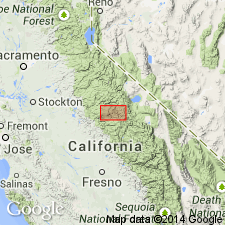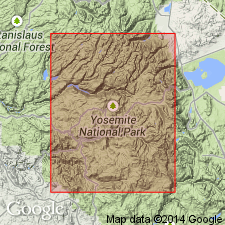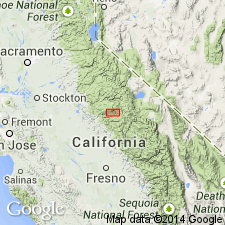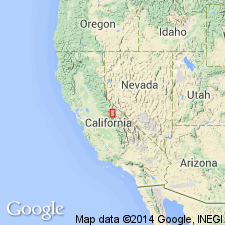
- Usage in publication:
-
- Johnson granite porphyry*
- Modifications:
-
- Named
- Dominant lithology:
-
- Granite
- Porphyry
- AAPG geologic province:
-
- Sierra Nevada province
Summary:
Named derived from Johnson Peak, south of meadow, Yosemite National Park. [no type designated] Is youngest most siliceous rock of Tuolumne intrusive series. Occupies area 7 mi from north to south and 2 mi from east to west; composes Johnson Peak. Surrounded by larger mass of Cathedral Peak granite which it intrudes. Its major part resembles an aplite, but distinguished by widely scattered phenocrysts of microcline. Part has texture of granite porphyry. [Is probably Cretaceous(?) age]
Source: GNU records (USGS DDS-6; Menlo GNULEX).

- Usage in publication:
-
- Johnson granite porphyry*
- Modifications:
-
- Geochronologic dating
- AAPG geologic province:
-
- Sierra Nevada province
Summary:
K-Ar age on sample (location shown on sketch map) on biotite from Johnson Granite Porphyry yielded 82.4 Ma. Younger than Cathedral Peak (83.7 Ma) and older than Hoffmann quartz monzonite (new) (83.3 Ma).
Source: GNU records (USGS DDS-6; Menlo GNULEX).

- Usage in publication:
-
- Johnson Granite porphyry*
- Modifications:
-
- Age modified
- AAPG geologic province:
-
- Sierra Nevada province
Summary:
Described as porphyritic rock, lighter-colored and finer-grained than Cathedral granite; contains a little biotite but no hornblende. Age of Johnson Granite Porphyry is changed from Cretaceous(?) to: Cretaceous, 3-21-61.
Source: GNU records (USGS DDS-6; Menlo GNULEX).

- Usage in publication:
-
- Johnson Granite Porphyry*
- Modifications:
-
- Age modified
- AAPG geologic province:
-
- Sierra Nevada province
Summary:
Age of Tuolumne Intrusive Series which includes Johnson Granite Porphyry is early Late Cretaceous (Evernden and Kistler, 1970, p.17)
Source: GNU records (USGS DDS-6; Menlo GNULEX).

- Usage in publication:
-
- Johnson Granite Porphyry*
- Modifications:
-
- Revised
- AAPG geologic province:
-
- Sierra Nevada province
Summary:
Johnson Granite Porphyry does not occur in Merced Peak 15' quad. Name Tuolumne Intrusive Series changed to Tuolumne Intrusive Suite [see recommendation by Sohl (1977) in which "suite" is proposed as term of group rank, adopted as Art 10(i) in Code]. Suite includes (oldest to youngest) granodiorite of Grayling Lake, granodiorite of Kuna Crest, granite of Marie Lakes, Half Dome Granodiorite, Cathedral Peak Granodiorite and [Johnson Granite Porphyry].. Age is Late Cretaceous.
Source: GNU records (USGS DDS-6; Menlo GNULEX).
For more information, please contact Nancy Stamm, Geologic Names Committee Secretary.
Asterisk (*) indicates published by U.S. Geological Survey authors.
"No current usage" (†) implies that a name has been abandoned or has fallen into disuse. Former usage and, if known, replacement name given in parentheses ( ).
Slash (/) indicates name conflicts with nomenclatural guidelines (CSN, 1933; ACSN, 1961, 1970; NACSN, 1983, 2005, 2021). May be explained within brackets ([ ]).

